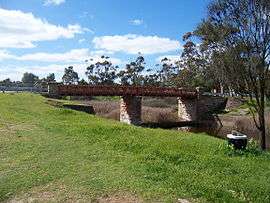Bremer River (South Australia)
| Bremer River | |
|---|---|
 Single lane Callington Bridge over River Bremer | |
| Country | Australia |
| Basin | |
| Main source |
Mount Lofty Ranges 431 m (1,414 ft) |
| River mouth |
Murray Mouth 0 m (0 ft) |
The Bremer River is a river in South Australia that rises on the eastern side of the Mount Lofty Ranges at an altitude of 431 metres[1] and drains into Lake Alexandrina at the lower end of the Murray-Darling Basin. Major tributaries of the Bremer River are Mount Barker Creek (draining the town of Mount Barker) and Dawesley Creek (rising near Brukunga)[2]
Nomenclature
One recorded Aboriginal name for the Bremer River was Miochi.[3] On 31 December 1837 the original European discoverer, Robert Cock, named it the Hindmarsh River, in deference to the first Governor, John Hindmarsh. This led to the following proclamation by the second Governor, George Gawler, appearing in the South Australian Gazette, effective 26 June 1839, ‘His Excellency the Governor having observed that to the southward [of Adelaide] there are two rivers named ‘The Hindmarsh’ – one flowing into Encounter Bay, and the other into Lake Alexandrina – is pleased to direct that the latter river shall in future be named the ‘River Bremer’, in the public maps, in order to avoid confusion in the geographical description of the province.’[4] The man so honoured by the renaming was the distinguished British Royal Navy officer James Bremer, who happened to command HMS Alligator, which conveyed Hindmarsh back to England.
Geography
The largest town in the catchment area is Mount Barker. Other towns include Nairne and Kanmantoo. Towns on the Bremer River itself include Harrogate, Callington and Langhorne Creek, where the floodwaters are used to irrigate the local vineyards.[5]
References
- ↑ "Map of Bremer River". Bonzle Digital Atlas of Australia. Digital Atlas Pty Limited. Retrieved 2008-07-16.
- ↑ "Bremer River near Hartley". Environment Protection Authority, Government of South Australia. Archived from the original on 2008-07-21. Retrieved 2008-07-17.
- ↑ Register newspaper, 24 October 1840, page 4.
- ↑ Southern Australian, 3 July 1839, page 4.
- ↑ "Langhorne Creek". South Australian Tourism Commission, Government of South Australia. Retrieved 2008-07-17.
- "Bremer River Catchment" (PDF). Environment Protection Authority, Government of South Australia. Archived from the original (PDF map) on 2007-08-31. Retrieved 2007-07-17.
Coordinates: 35°23′24″S 139°03′05″E / 35.3900°S 139.0514°E